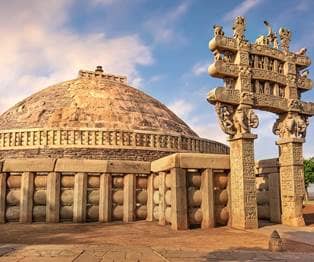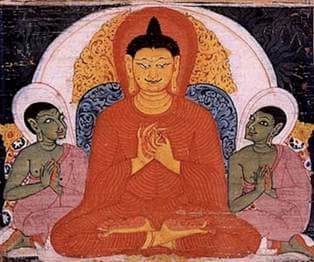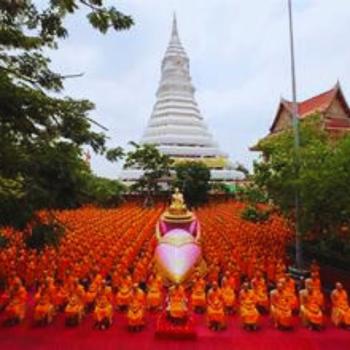- Trending:
- Forgiveness
- |
- Resurrection
- |
- Joy
- |
- Afterlife
Buddhism Ethics and Community
Community Organization
Community (sangha) is one of the "three jewels" of Buddhism. (The other two are the Buddha's teachings [dharma] and the Buddha himself.) Originally the sangha was a term describing the community of monks, but it grew to include lay participants, and now refers to the Buddhist community as a whole.
As Buddhism shifted from groups of wandering ascetics to organizations with stable, physical structures, it was always integrally connected to the communities within which these structures were built. Among the earliest known Buddhist activities that included lay participants were those that occurred in the location of stupas. These areas became sites for pilgrims to visit, and also for joyous festivals involving locals and visitors in multifaceted events that at once entertained, informed, and generated merit. Gradually, more and more monasteries were built, not only near these stupa sites but also in many other locations in South Asia. As Buddhism was established throughout Asia, the monastery became its fundamental institutional structure.
Although Buddhism was initially disruptive to social structures by drawing men away from their social obligations, it soon became a productive contributor to local communities. A Buddhist monastery provided its community with religious rituals, spiritual guidance, places of worship, and a means of earning merit. Buddhist laypersons sometimes formed social clubs that arranged pilgrimages, met to chant or copy sutras, or carried out projects for the benefit of others.
Buddhism became known as a source of practical benefits for its followers. This practice grew from the texts and stories about the bodhisattvas, who provided spiritual rescue but were also said to be able to protect people from dangers such as fires or floods. One might visit a monastery to ask for healing for a loved one, for help finding a marriage partner or a job, to insure the birth of a healthy child or grandchild, or to ask for success in examinations or a myriad other things that would benefit one's life.
Monasteries also served social needs by determining auspicious dates for weddings, telling fortunes, and, in some cases, providing political clout or mediating between locals and the government. In addition to sponsoring festivals, they also sometimes held large vegetarian feasts to which all the locals were invited, paying a donation only if they were able.
Monasteries sometimes served as inns, offering beds and meals for travelers. Some provided social services such as schools, orphanages, health care facilities, food and shelter for the homeless, facilities for the elderly, and even animal rescue. Occasionally they carried out public works projects, such as building roads and bridges, digging wells and planting trees along travel routes, deepening river channels, or creating reservoirs to provide communities with fresh water.
Over time, Buddhism merged with the cultures to which it was introduced, being shaped by them and shaping them in turn. Perhaps because of the way it was spread, by word of mouth rather than by military force or coercion, and because of an attitude of acceptance toward other religions, there was relatively little conflict between Buddhism and indigenous religions. Buddhism was so successful in China, for instance, that the Daoists and even the non-religious Confucians imitated Buddhist institutional structures.
In some countries, during some eras, Buddhism was an official state religion, and in those situations Buddhist monasteries conducted rituals on behalf of the state, called on the powers of protective deities, and offered prayers to repel invaders in times of war. In China, monasteries sometimes served as retreats for scholars and government officials. Also in China, during the era when Buddhist monasteries were often quite wealthy, the monasteries sometimes lent money, charging interest at prevailing rates. Buddhist monasteries were also sometimes centers of rebellion, leading people who revolted against unfair rulers or poor social conditions.
Today's Buddhist monasteries come in many shapes and sizes. They may be identified with families, neighborhoods, villages, cities, or nations. They offer many of the same services and opportunities, both sacred and secular, that monasteries have offered historically. The Buddhist monastic complex of buildings, statues, open landscapes, and ritual spaces is a place where people gather in communal celebration with others, and it is often the social center of a community.
- What are some of the rituals laity can perform?
- Describe the role of the monastery.
- What role has Buddhism played in shaping politics?
Leadership
The language used by English scholars to describe Buddhist clergy and Buddhist institutions is problematic, in that it is easy to make assumptions based on what that term means in English. Whereas in Catholicism there are priests who preside over rituals in churches, and monks who lead contemplative lives in monasteries, within Buddhism both of these functions are fulfilled within one institution. Scholars, wanderers, the married clergy of Japan, the ascetics — all are usually called "monks" in English, although on occasion the term "priests" is used. Resorting to indigenous terms is not a satisfactory solution to this problem, as each country has its own language and categories.
What all of these individuals have in common at first glance is that they wear distinctive robes. The appearance of the robes varies according to region and sect, and there are special robes for those undertaking a particular pilgrimage or feat of asceticism. Regardless of these differences, a member of the Buddhist clergy is always instantly recognizable to the public. All monks are also bound by the vinaya, or rules of discipline, although in practice, the degree to which the vinaya is followed varies.
It is difficult to make generalizations about Buddhist leadership structures. Organizational structures vary from region to region and sect to sect. Some are strictly hierarchical; others are run like a family business. Some have central governing bodies; others do not. Some are aligned with the government; others are oriented toward the community; some serve both.
Given these disclaimers, a few generalizations can be made. There is almost always some kind of hierarchy that may be based on experience or accomplishment. Typically there is one individual in charge of a Buddhist institution, but there are others in positions of significant responsibility. For example, in Japanese Zen temples, the Roshi, or spiritual head, is in charge of teaching novices, but there is also a head monk who is in charge of the practical business of running the institution. In the large monasteries, there are many officials in charge of different aspects of a multi-faceted and complex organization.
The duties of clergy toward laypersons are varied. Monks will perform rituals on request, such as funerals, and they also conduct the ceremonies on the yearly ritual calendar. In a popular temple, monks might also tell fortunes, sell talismans, or create calligraphic seals for tourists. All the monks work together to prepare for holiday and festival celebrations. If the monastery has a school for children or a university, some of the monks serve as teachers. If it is a monastery that trains monks, senior monks will serve as meditation teachers, scripture teachers, and so forth. Some monasteries offer vocational training for the laity; others operate medical clinics. In some monasteries, the day to day labor-cooking, cleaning, and so forth is done by lay volunteers; in others, particularly in Japanese Zen monasteries, all the work is done by the monks.
Even in the modern world, there are still Buddhists who wander alone. Some of these will have a home institution that supports them, others will not. There are other Buddhist clergy who do not live in monasteries. They may teach at a university that is not affiliated with the religion, or they may run a non-monastic institution, as do the Taiwanese nuns who run the huge Buddhist charity Tzu Chi. A few monks simply choose to live alone and support themselves.
Traditionally there were also traveling teachers who taught Buddhism; these were skilled storytellers who were entertainers as well as teachers. While this practice is rare today, there are now Buddhist teachers who write books and make television appearances in which they explain Buddhist views in a public forum and comment on current issues.
This section would not be complete without mentioning that while all monks are supposed to follow a strict code of discipline and serve as role models for the community, this is an ideal that is not always met. Because of this, a stereotype in popular literature and film in Asia is the Buddhist monk who is stupid, incompetent, lecherous, or immoral. Another stereotype in literature and film is the monk who has supernatural powers and is able to accomplish amazing feats of magic.
In reality, monks are a diverse lot, with the same differences in character that one might expect among the general population, or among the leaders of any religious body. They are distinguished from others only by their choice to devote their lives to Buddhism. They sacrifice the benefits of an ordinary life to gain the spiritual benefits of their practice and service to the community.
- Is it accurate to compare Buddhist monks to the western understanding of clergy? Why or why not?
- Who can become a Buddhist monk?
- How are Buddhist monks visibly set apart from laity?
- How do monks serve the laity?
Principles of Moral Thought and Action
One of the fundamental Buddhist principles of moral thought and action is karma. Until such time as one becomes enlightened, one's actions in this life will determine the nature of future rebirths. A related concept fundamental to Buddhism is merit. Acts of generosity toward and support of Buddhist monks are channeled by the monks toward advancement for the giver in future rebirths or toward improving the lot of deceased relatives.
The Buddha's Four Noble Truths are another guiding principle of moral thought and action, particularly as expressed in the fourth truth, the Eightfold Path. The motivation for following the Four Noble Truths is not to "be good" per se, but to facilitate the realization the Buddhists call enlightenment. The English translation of the terms within the path does nothing to dispel the impression that the Eightfold Path is a series of moral injunctions — "right effort," "right livelihood," etc. — as the term "right" in English implies "correct." A more accurate translation for "right" in this case might be "skillful."
Practically speaking, since the earliest days of Buddhism, many have regarded the Eightfold Path as a set of guidelines for correct behavior, and it is not difficult to see why. Even in the early texts, the Buddha often mentioned "do nots" when discussing the Eightfold Path.
The eight items in the Eightfold Path are often divided into three categories: right view, right conduct, and right practice. These classifications are aids to remembering and understanding the nature of each item in the list. It is important to note that the Eightfold Path is not a series of consecutive steps like the 12 steps of Alcoholics Anonymous. In a sense, each is a path in and of itself. For example, it is not necessary to establish "right understanding" before undertaking "right livelihood."
Right view (Prajna)
1. Right understanding: Recalling that the first step in dependent arising is ignorance, it is not surprising that the first item the Buddha mentioned in listing the Eightfold Path was right understanding. To have right understanding is to comprehend that life is impermanent and that one's illusion of a separate and individual self contributes to one's dissatisfaction in life.
2. Right thought: To cultivate right thought is to avoid unhealthy states of mind that give rise to suffering, such as greed or anger or hatred. This path is not just about avoidance, however; often called right aspiration, it involves actively cultivating compassionate thoughts and positive wishes for others.
Right conduct (Shila)
3. Right speech: The Buddha taught that wrong speech included lying, slander, harsh words, and gossip. As in the previous case, it is not enough simply to avoid these; one must also cultivate speech that is kind and compassionate.
4. Right action: Actions that are not "right" are those that are forbidden by the five precepts: lying, stealing, killing, taking intoxicants, and sexual misconduct. Instead, one must act with respect, generosity, self-control, honesty, and compassion.
5. Right livelihood: One should not pursue an occupation that harms or exploits others, nor should one be motivated by a big salary or hope to earn more than one needs. The right livelihood is one that provides for one's needs while at the same time serving others and improving the human condition.
Right practice (Samadhi)
6. Right effort: To follow the Buddha's teachings is difficult and requires conscientious effort. This effort need not involve straining or struggling. Instead of trying to prevent wrong thoughts or speech, for example, one can, when they occur, simply let them go. One could try to understand them without allowing them to fester, or one could visualize the negative consequences if they are allowed to persist. Another method is to consciously cultivate more productive mental states. One can also change one's environment to one that is more conducive to following the proper path.
7. Right mindfulness: To be mindful is to be aware of one's thoughts, feelings, and actions so that one is not controlled by them. In addition, mindfulness is awareness of the nature of the world and its operations.
8. Right concentration: This involves a one-pointed focus on spiritual realization. It is a way of avoiding distractions and disruptive emotions and directing the mind toward productive action. The Buddha taught specific practices to cultivate right concentration, forms of meditation that encouraged either tranquility or insight.
The Eightfold Path, along with the concepts of merit and karma, while originally directed toward the ultimate goal of enlightenment, serve also as behavioral guidelines. Within the Buddhist world, these concepts effectively inspire moral behavior and foster social harmony.
- Describe the relationship of merit and karma.
- Describe how the eight items of the Eightfold Path are categorized. How do they relate to one another?
- What is meant by right as it is used within the Eightfold Path?
Vision for Society
This Buddhist vision for society evolved as the religion expanded; it was not part of the Buddha's original vision under the Bodhi tree. The Buddha had been seeking a path to enlightenment and escape from samsara, and his focus was on sharing his insights with the renunciants who followed him.
As conflicts and problems arose among his followers, the Buddha dealt with them by establishing strict rules of discipline on a case-by-case basis. Strong lay support soon put the Buddha in a position of also having to create social structures beyond his monastic order. As he had with the renunciants, the Buddha established rules of appropriate behavior. He also urged his lay followers to respect and have compassion for all beings.
Alliances with local rulers furthered the Buddhist social order. According to Buddhist texts, at first the Buddhists were seen as a potential threat. They had been given a considerable amount of land, making the organization quite wealthy. To minimize this fear of political rivalry, the Buddha stated that any monk or nun who engaged in any sort of political activity, even as tenuous as carrying messages or running errands for a lay person, would be banished. The threat was further mitigated when two of the most powerful rulers in the area became disciples.
The Buddha did not attempt to gain political control, but he did have ideas about how rulers should govern. He taught that they had an obligation to the people they ruled. He taught that in the ideal society rulers would be fair and obey their own laws, and would freely provide grants to their subjects so that they could set up businesses.
Ashoka, who ruled most of South Asia a few centuries after the Buddha died, put these and other Buddhist ideals into practice in the lives of ordinary people throughout his empire, creating a model for future Buddhist kingdoms. Ashoka took responsibility for the well-being of his subjects. He had trees planted and wells dug to provide places of rest for travelers. He provided medical treatment for them, and even for their animals. He also instructed his officials to be fair and impartial, and sent inspectors to make sure that they were.
Ashoka placed edicts all around his empire and beyond, encouraging his subjects to be respectful and obedient to parents, elders, teachers, and religious leaders, and also to treat friends and servants with respect. He instructed them to cultivate positive moral qualities such as kindness, honesty, and frugality, and to avoid character flaws such as cruelty, arrogance, and laziness. He also advocated religious tolerance. Ashoka was later known as the "Dharma Raja," the king who rules according to the Buddha's teachings.
As Buddhism spread and expanded, many Asian rulers welcomed the Buddhist organizations because they encouraged people to maintain strict moral principles, and some followed Ashoka's model as rulers. Ideally, the people benefited from a greater concern shown to them by rulers who considered their needs. They also received spiritual guidance and practical benefits. Rulers received the advantage of a well-behaved populace, and the monasteries received financial support and official recognition.
This was the ideal, and, as is often the case, the reality usually fell short of the ideal. Sometimes rulers disregarded the needs of the people. Sometimes the monasteries became wealthy and corrupt. Sometimes there were monks or lay people who mistreated and exploited others. Many times, however, rulers, monks, and communities benefited from supporting and cooperating with one another.
The specifics of Buddhist social organization changed with time and place, but the central idea of social harmony and cooperation between all levels of society remained a focal point of the religion as Buddhism moved from country to country. The goal was to unite the entire cosmos and all beings within it — whether god or human, animal or plant, living or dead — into one harmonious whole.
- Why where Buddhist social structures first created?
- What did the Buddha's teachings offer to politicians? Why were the teachings beneficial to them, as well as their constituents?
- What was Buddhism's goal as it expanded?
Gender and Sexuality
Monks, nuns, and laypersons vow to avoid sexual misconduct. The early texts forbade any sort of sexual activity to monks and nuns, but in practice, in some Buddhist countries, heterosexual or homosexual liaisons involving monks have been accepted without great condemnation. Expectations for nuns have been stricter, due to cultural norms regarding women. In Japan and Korea, Buddhist priests typically marry, but nuns do not.
For laypersons, no specifics are given as to what constitutes sexual misconduct. In a broader ethical discussion in one of the early texts, the example is given that sexual intercourse outside of marriage would be "unpleasant" for one's spouse, and thus should be avoided. Some countries condemn abortion and divorce but most do not, based on societal norms rather than religious regulations. In Buddhist countries where abortion is forbidden, the Buddhist precept against killing is cited.
Buddhist ethics have been oriented toward maintaining social harmony rather than a concept like the Christian notion of "sin." Under the influence of Westernization, however, some Buddhist countries have adopted stricter attitudes in the 19th and 20th centuries.
Gender equality in Buddhism has been a topic of much scholarship in the last thirty years. According to early textual accounts, the Buddha's own stepmother approached him along with a group of women, asking to join his group; when he refused, they shaved their heads, put on robes, and followed the Buddha anyway. Ananda, one of his trusted followers, interceded with the Buddha on the women's behalf, repeating the request that they be allowed to join several times. While the Buddha finally did agree, the texts state that he imposed extra regulations that placed the women in an inferior position to the men, and predicted that this would shorten considerably the amount of time that his teachings would be remembered.
Feminist scholars have suggested that some elements of this story were inserted into the texts later, and that, given his dismissal of strict caste divisions, one might expect the Buddha to have treated women as equal to men. Others argue that, while the Buddha may seem misogynistic to us today, his attitude was liberal for the 6th - 5th century B.C.E. He did accept women into the order and thus provided them with social freedoms and opportunities they might not have otherwise had.
A number of stories about women in the early Buddhist texts give some indication of who they were and what their place was within the community. Some were mothers or wives of renunciants who had no one left to take care of them. Others were women who abandoned their lives to wander, many of them daughters of the wealthy who were intelligent, independent, and deeply interested in spiritual matters. Some of them defied social norms with courage and a few undertook extreme acts, such as disfiguring themselves, in order to be allowed to become nuns. There were also many stories of laywomen who generously supported the Buddha and his followers.
The texts include quite a few negative stories and express many negative opinions about women. The female body was described as a source of pollution: childbirth was polluting; sexual intercourse was polluting; menstruation was polluting. Women were portrayed as temptresses who were to be avoided at all times. One visualization practice for monks, attributed to the Buddha, was to imagine the corpse of a beautiful woman as it deteriorated after death.
According to some of Buddhist texts, women could not become enlightened, but must first be reborn as men. This is not a consistent view, as the Buddha's stepmother was said to have become an arhat, and there is no mention of such a transformation in her case. In the Mahayana sutras, the doctrine that women could not become enlightened without first being reborn as men was called into question.
Because of women's lower status, Buddhist nunneries have never been as successful as the monasteries. It has been more difficult for them to raise funds to support themselves and maintain their infrastructure. In some Buddhist countries, the order of nuns shrank centuries ago to the point where there were not enough nuns left to ordain new ones and the orders disappeared. In some countries, ordination for women was never allowed.
As Buddhism has entered the Americas and Europe, new female converts have been active in working to change the status of these women. In the late 20th century, a few Sri Lankan nuns came to the United States to be ordained at a Taiwanese temple. Eight years later, some Sri Lankan women traveled to India to be ordained by Korean Buddhists. While some male monks in Sri Lanka objected to this radical change in tradition, the ordinations were popular with the people, and the order of nuns was restored in Sri Lanka. An order of nuns in Mongolia was also established in the late 20th century.
Orders of Buddhist nuns have remained viable in Vietnam, Laos, and Cambodia, as well as in Japan, China, and Korea. The strongest organization of nuns in the modern world is in Taiwan, where the number of women entering monastic life outnumbers men by five to one. Taiwanese Buddhist nuns are famous educators, artists, and activists. The largest civic organization in Taiwan is Tzu Chi, which was founded by a nun in 1966 and is run by Buddhist nuns. Tzu Chi has organized a number of social service projects and distributes tens of millions of dollar every year. As the example of Taiwan indicates, it is very likely that the status of Buddhist nuns will change as attitudes toward women change in the modern world.
- How does the notion of sexual misconduct vary across Buddhism?
- Is abortion debated by Buddhists? Why or why not?
- Why is there debate about the role of women in Buddhism?
- How has the status of women continuously evolved over time?








